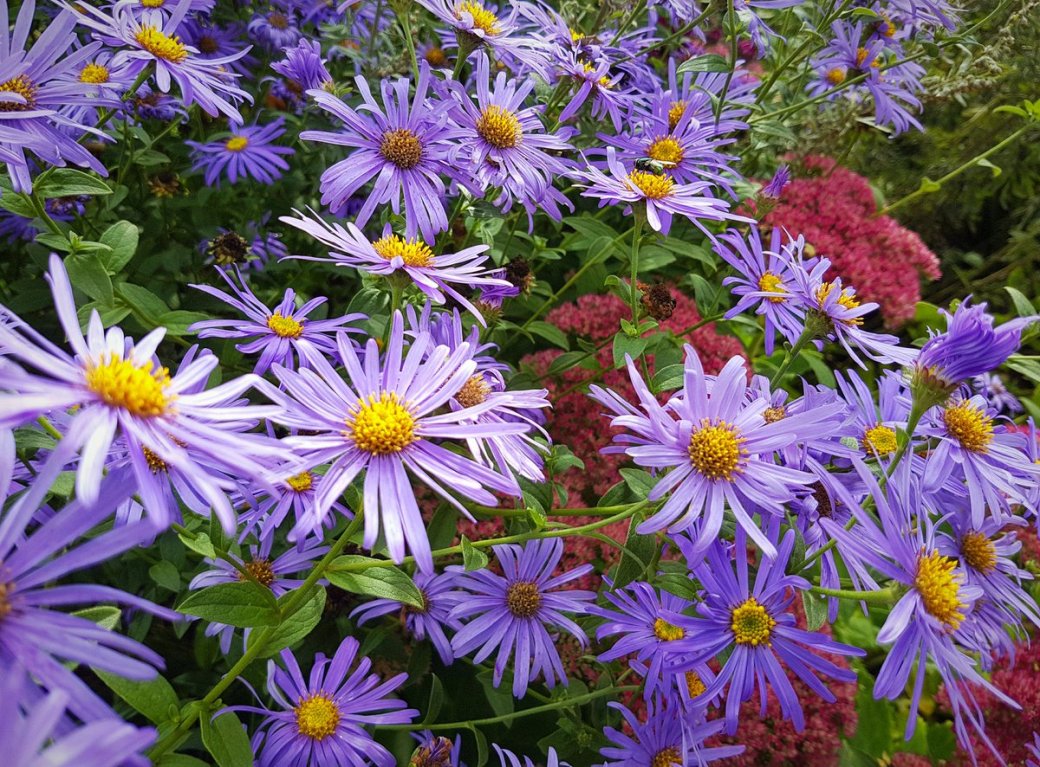Michaelmas daisy

Aster frikartii is a hybrid of A. thomsonii and A. amellus and can give a generous display for three months, lavender-blue, wide flowers on a self-supporting stem — if you get the best and genuine form, Monch. There are, unfortunately, imposters about. The true plant is definitely rigidly upright, and the petals are in one plane. It carries on flowering until about mid-October.
Margery Fish
The excellence of Aster frikartii Mönch hardly needs repeating, its long season from June to October adding to the elegance of its straight-rayed flowers and its cool colouring.
As Bowles points out, Aster amellus has a habit of carrying its flowers in a plateau of shimmering purple, although sometimes starting to flower a little early, the simplicity of these sparkling discs woven together into a rich carpet takes the breath away. Aster frikartii ‘Monch’ is distinguished by its distinctive flat flowers; the ray florets stand out almost perfectly flat from the disc, with few above or below the general line. It is a clear blue and reaches about 3ft in height.
Graham Rice

So, with good manners, good breeding and grace in mind, I have whittled the vast list of asters down to a handful of good clump formers. Of the well-behaved asters, few are better than Aster x frikartii Monch. A plant of about 2ft high, with large lavender flowers, Monch comes into flower in August, at the beginning of the aster season, but it continues for months if it is happy. While most asters actively prefer a poorer soil, Monch likes a handsome mulch of compost in the spring and division every five years or so to replenish clumps with the best and strongest offshoots. I like this variety most with the bright bubblegum-pink of Nerine bowdenii, but they are just as lovely against the neutral silveriness of lavender.
Dan Pearson
Two more names I cannot omit are Aster x frikartii Monch and Aster thompsonii Nanus. These two blue-flowered asters are without equal. They bloom for at least three months, never suffer from attacks of mildew and need no staking. They each make, in effect, a dome of blue, drawing you across the garden to admire them. A. thompsonii Nanus is the smaller of the two, about 15 inches (38cm), with slightly paler flowers. I use it in mixed posy bowls for weeks on end, until the first frost spoils most flowers for picking.
Beth Chatto
Monch is an aster hybrid between two species found in dry places and it thrives in British gardens, unlike so many asters that are bred from American species found naturally in marsh-like conditions. Many of these succumb to wilt, mildew and generally look miserable in British gardens. One parent is Aster amellus, the Italian starwort, and the other is a Himalayan species called Aster thomsonii found on dry woodland edges. Neither are that spectacular on their own, although both have grace, a long-flowering season and an ability to colonise dry places.
Monch’s rough, dark-green foliage looks handsome by early summer. The arching stems are topped by violet-blue flowers, each with a double row of finely rayed petals set round a golden middle.
Val Bourne
Amongst the early summer daisies perhaps my favourite is Aster frikartii ‘Monch’. Whereas most of our later summer and autumn daisies have a North American ancestry, its parents are both from this side of the Atlantic. One, A. thopmsonii is from the Himalayas, the other is the Italian starwort, A. amellus. It has rough leaves and isn’t subject tot he nasty mildew that besets the novi-belgii group of Michaelmas daisies. But its virtues are so much more than that, starting with its deportment, It makes a branching bushy plant, though the stems are held separately from one another so you can appreciate its shape and see its delightful blue daisies distinctly. The flower heads are beautifully balanced, a neat centre that starts green and becomes brilliant yellow as each of the disc florets, the individual flowers making up the centre, opens and reveals its pollen, encircled by a ring of slender blue petals, the ray florets. It’s a sterile hybrid, which means that though it cannot produce seed, it has no reason to stop flowering. It’s also as hardy as can be and truly perennial.
Carol Klein
Frikartii Monch is a hybrid but still correctly an aster, the marvellous single-flowered one whose lavender-blue flowers appear from late July to October, reaching about 3ft but usually falling forwards, making it ideal for a big border’s front row.
Robin Lane Fox